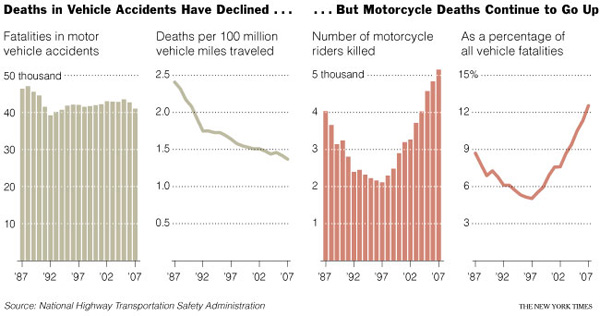
What Works
This story is a little dated – it was published when gas prices were at $4 a gallon. The facts, as written, look something like this: “Deaths on motorcycles hit a low of 2,116 in 1997. Since, they have risen 128 percent. Their share of crash fatalities has jumped to almost 13 percent from 5 percent.” In this graphic, we’ve got absolute numbers of fatalities by vehicle type in the bar graph and some sort of relative measure in the line graphs. I am not sure four graphs together is the most elegant way to show this information, but it does the trick. We see that car fatalities are trending downwards slightly while motorcycle fatalities are trending upwards. What we don’t see is that fewer cars were on the road and more motorcycles were out there. People shifted from gas guzzling cars to more efficient motorcycles or to public transportation. One would expect that with more motorcycles there would be more motorcycle accidents and that with fewer overall drivers there would be fewer car accidents. So how much of this is a real change in the relative danger of riding a motorcycle versus driving a car, which is what these graphs and the accompanying story are trying to suggest exists?
What Needs Work
I like that the absolute measures of car fatalities and motorcycle fatalities are directly comparable. I don’t like that they chose to look at two different relative measures. We’ve got deaths per 100 million miles driven for cars and motorcycle deaths as a percentage of all vehicle fatalities for our relative measures and that just doesn’t make for any kind of rational direct comparison. They are two completely different kinds of measures.
Note
Wear helmets. A mind is a terrible thing to waste, especially when it’s your own.
Relevant Resources
Wald, M. (2008, 14 August) Deaths of Motorcyclists Rise Again in The New York Times, US Section.
